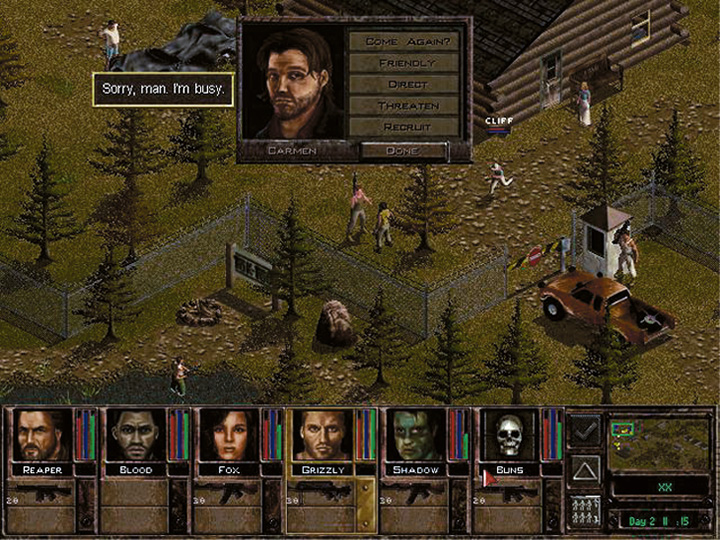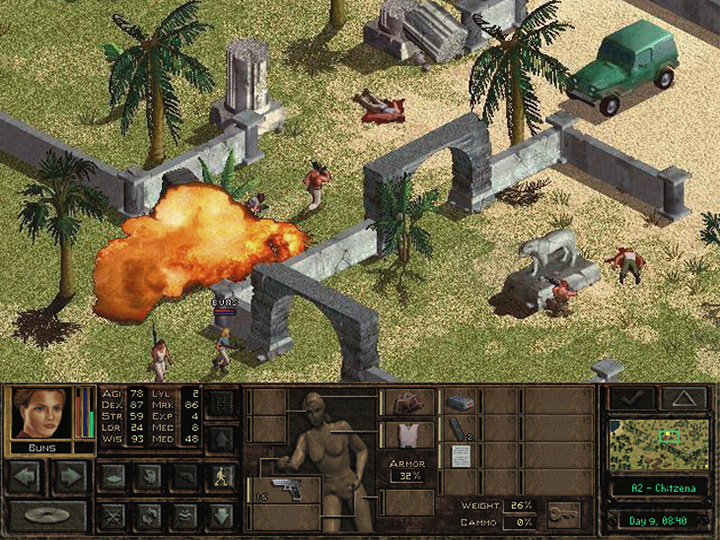It’s been 20 years since Sir-Tech’s Jagged Alliance 2 came out and you would think, in all that time, someone would have copied its formula successfully. But despite the renaissance in great tactics games over the past several years, almost none of them have even attempted to mimic its tough, player-directed dynamic campaign. Lately I’ve started to wonder whether this is about a tough design challenge, or a deeper discomfort with making a game about the kind of guerilla insurgency that Jagged Alliance 2 captured so well.
Jagged Alliance 2 is recognizably a relative and peer of games like Fallout 2. It might be from 1999, when 3D graphics were transforming what video games looked like and how many of them felt to play, but JA2’s sprites, forced isometric perspective, and most of all its incredibly fussy and detailed RPG interface mark it as a game of very old-school sensibilities. Yet it’d be a mistake to think it was behind the times. Rather, Jagged Alliance 2 was a game whose ambition lay in melding tactical combat with an unforgiving strategic layer context. It’s not a perfect comparison, but it’s a bit like what you might get if XCOM were crossed with a Total War campaign.
Jagged Alliance 2 puts you in charge of a mercenary company tasked with overthrowing a violent dictatorship in the fictional country of Arulco. You recruit a band of misfit, amateurish mercenaries, then begin waging a guerilla war across a huge map of the entire country. Each sector is a specific tactical map where combat can occur. There are small towns and a couple relatively large cities and, most importantly, there are mines that you can take over to fund your ongoing war effort. You see, after the opening of the game, you have to pay your staff, hire additional mercenaries to increase your numbers, and place mail-orders for 7.62mm ammo, kevlar vests, and hand grenades. It’s a lemonade-stand business sim, but for paramilitary violence.

I’ll be the first to concede that the whole vibe of the game is weird. In his book about JA2, writer, developer, and super-fan Darius Kazemi gets into the strange combination of gun fetishism and goofy comedy the typifies the game. It’s a game for people who dreamed of living the improbable adventures they read about in Frederick Forsyth books and Soldier of Fortune magazine, made by people who thought all of that was hilariously asinine. Your character are almost universally meatheads who wouldn’t have been out of place in Predator or Aliens, and they’ll develop weird personality clashes or synergies that make squad chemistry an ever-shifting variable. I had one campaign derailed because of a “DON’T EMAIL MY WIFE” meltdown that caused a couple of my best, most experienced troops to quit the campaign at the exact moment I needed all-hands-on-deck.
But what the game does really brilliantly is capture the slow, uneven escalation of a small local rebellion into a bitter guerilla war and finally into a full-fledged clash between elite conventional armies. After some relatively straightforward opening moves where you secure a couple towns, an airfield where you can get supplies shipped-in, and a silver mine or two, the regime hits back with the force of a sledgehammer.
Following a cutscene of the evil queen Deidranna sending in her elite troops, all hell breaks loose. You go from fighting second-rate gunmen wearing literal redshirts and carrying handguns to battling black-clad elites sporting first-rate military equipment and full body-armor that outclasses most of the weapons your soldiers carry. These royal guard units quickly begin retaking territory you’ve seized, and unless you can win a couple battles against them and loot their gear, you probably won’t have anywhere near the firepower to stop them. Making matters worse, some of them carry sniper rifles and night-vision equipment, meaning that the kind of night battles that gave you an early-game advantage suddenly become impossible until you get specialized night-fighting gear (which, again, you’ll probably have to take off their dead bodies).
It’s a vicious difficulty spike that often undoes significant amounts of progress before you can stem the tide and resume the offensive. And it transforms the campaign from a series of standup gunfights to a wave of hit-and-run ambushes, or bloody attritional battles in cities defended by friendly militias that you’ve invested time and money into training. But on the other side of all this hard fighting, you’ll likely be leading an elite army of heavily-armed guerillas deep into enemy territory as you lure enemy troops into ambushes, strike at weakly defended rear areas, and then evacuate before the counterattacks can arrive.
Which is all terrific as far as the structure and feel of this campaign goes, but I think it also suggests why so few games have attempted to follow in Jagged Alliance 2’s footsteps.

Jagged Alliance 2 was fortunate to be able to imagine an End of History geopolitical nullspace where it could project this fantasy of liberation without confronting imperial and post-colonial politics. Arulco could be any small, resource-rich nation where the United States or the Soviet Union waged proxy wars and sent their advisors. But the player is positioned an outsider hired on behalf of the “rightful” royal family to bring down the bloodthirsty tyrant queen who married a naive prince, seized power, and replaced a benevolent limited monarchy with brutal dictatorship. While you might be working to restore an exiled royal family, it’s made clear at every turn that their reinstatement would restore a nation to its people. Jagged Alliance 2 offers a colonial adventure without the imperialism, where the foreign guns-for-hire would be on the side of freedom fighters rather than their oppressors.
In 1999, it was easy to play tactical dress-up with a classic underdog story of insurgents slowly growing in training and capacity as they bled a superior military power to death. It’s the foundation myth of the United States and a favorite pop-cultural trope. Audiences consistently and lovingly embrace these narratives despite the fact that the United States and many other western countries have been quashing insurgencies and anti-colonial resistance for centuries. But in the era of 1990s peacekeeping missions and humanitarian interventions, it was easy to imagine a world full of evil dictators who deserved toppling if only some heavily-armed badasses were up to the job.
Within a few years, however, the United States and its allies would be fighting wars of occupation and “nation-building” in Afghanistan and Iraq, against people who lived there and who did not, it turns out, gratefully regard invading armies and their bombers as welcome liberators. By 2002, American pundits were arguing that maybe the Galactic Empire wasn’t so bad, if you really think about it. In the 20 years since Jagged Alliance 2 came out, there’s scarcely been a moment when the news has not been dominated by an ongoing American effort to use technological supremacy and prowess to overcome massive unpopularity and resistance to foreign occupation and domination.
The humor of Jagged Alliance 2 always required a presumption of distance and of innocence. The end of the Cold War had not ended the violent legacies of anti-communist interventions around the world, or narco-conflicts, or the installation and maintenance of strongmen. In 1999, it was briefly easier to tell a story of underdogs battling a professionalized, high-tech military and not be overwhelmed by uncomfortable resonance. That moment swiftly passed.
"What the game does really brilliantly is capture the slow, uneven escalation of a small local rebellion into a bitter guerilla war and finally into a full-fledged clash between elite conventional armies."
The new wave of tactics games that followed on the heels of Firaxis’ XCOM have continued to avoid the asymmetry and power dynamics of Jagged Alliance 2, even when the fiction seems to call for it. XCOM 2 offered up a heavily-scripted campaign that takes the language of insurgency and resistance but none of the strategy and few of the tactics. Fighting the alien occupier turns out to look a lot like Special Forces missions, but with more snakes and mecha-orbs. BattleTech took a page from Jagged Alliance 2 and had you throw your efforts behind a royalist restoration, but with some good writing buttressed by that universe’s feudal politics, the game sidestepped the messiness of a popular insurgency and instead portrayed a conventional civil war in which players had a minimum of agency. We still have plenty of games in which we are the ostensible underdogs, but never in a meaningful mechanical sense. Technology is an ally, not an antagonist. Battles take place on a roughly even footing, in spaces that we never visit outside of combat.
Yet that Jagged Alliance 2 campaign still beckons. There was something dangerous and exciting about how unfair its campaign could feel. How crushing it was to see enemy troops shrugging off submachine gun rounds at range because of body armor, or to have one of your best troopers drilled in the head, in the dead of night, by an enemy you could not even see. But on the other hand, I have scarcely ever had a victory as sweet as when I led an enemy squad on a long chase through the night and, at sunrise, had my troops lying in-wait for their pursuers in a dense forest. Jagged Alliance 2 is devoted to those types of unfair fights, and the way that technological supremacy warps and skews the very notion of fairness. It’s an interesting theme to explore in tactics and strategy games, but one whose disappearance in the intervening 20 years looks a lot like reticence.
from VICE https://ift.tt/2LFEyAE
via cheap web hosting
No comments:
Post a Comment